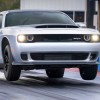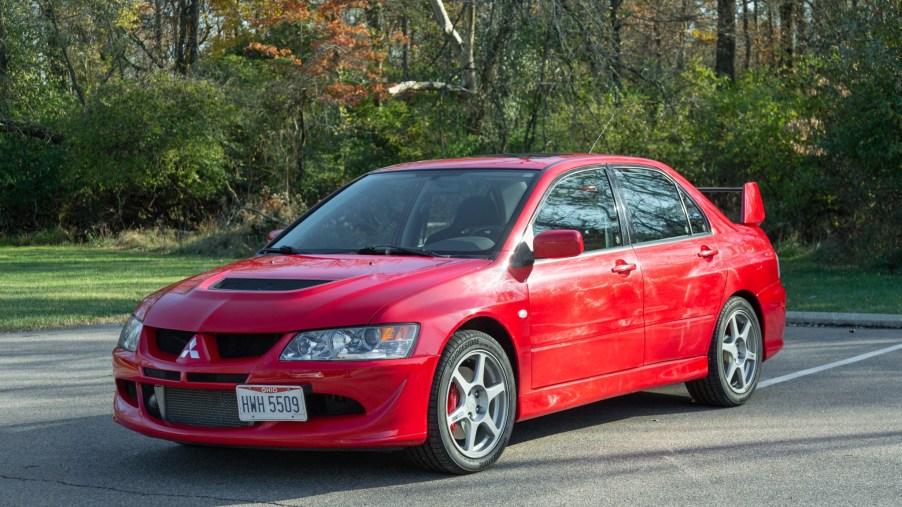
What’s the Best Year for the Mitsubishi Lancer Evo?
Although the Subaru WRX out-lived it, the Mitsubishi Lancer Evo still has plenty of fans. And there’s a growing demand for importing the models the US never got. Perhaps unsurprisingly, the rally-inspired all-wheel-drive performance sedan holds its value well. Most likely, that’s because examples untouched by Fast and Furious-inspired mods are getting harder to find. However, if you maintain it well, a Mitsubishi Lancer Evo can be a surprisingly reliable performance car.
The first US-market Mitsubishi Lancer Evolution
Although there have been 10 Mitsubishi Lancer Evo generations, only 3 made it to the US. The first, Jalopnik and Hagerty report, was the 2003 Mitsubishi Lancer Evo VIII.
As with the previous-gens, it had AWD and a 2.0-liter turbocharged 4G63 four-cylinder engine. For the Evo VIII, said engine put out 271 hp and 273 hp. That was more than the 2002 WRX, though slightly less than the 2004 WRX STI.
Mitsubishi didn’t just add more power to turn the Lancer into an Evo, though. The car received a roof and vented hood made from aluminum, Recaro sport seats, Brembo brakes, and a carbon-fiber rear wing. Despite a power deficit, Car and Driver ranked the Evo VIII ahead of the WRX STI. Although its interior was rather cheap, the sedan had “brilliant steering” and “telepathic handling.”

For 2005, Mitsubishi also released the MR model, Car and Driver reports, which came with a few noteworthy updates. Instead of the 5-speed manual, it got a 6-speed. Bilstein dampers were included, as was a limited-slip differential and updated active center differential. Engine output was also improved, to 276 hp and 286 lb-ft.
Its successors
The next model, the 2006-2007 Lancer Evo IX, took the Evo VIII’s charms and refined them. The Evo IX still used the 2.0-liter turbocharged 4G63 four-cylinder, but it now made 287 hp and 289 lb-ft. In addition, said improvements also improved fuel efficiency. The Mitsubishi Lancer Evo IX also had lighter wheels, new bumpers with improved intercooler air-flower, and new Recaro seats.
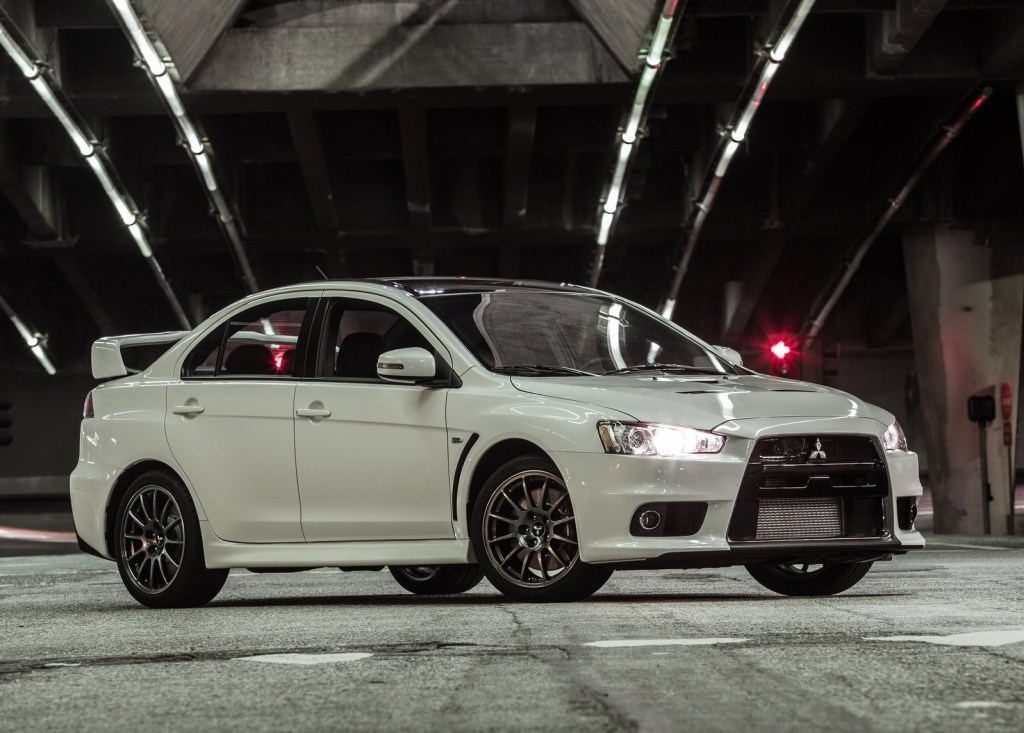
Finally, in 2008 came the final model, the Mitsubishi Lancer Evo X. It still had a 2.0-liter turbocharged four-cylinder, albeit with the new 4B11 design. The Evo X, Motor Trend reports, was a somewhat more refined Evo, if not quite as high-energy. Handling, though, was still excellent.
Admittedly, the sedan wasn’t exactly luxurious. However, it was more powerful, developing 295 hp and 300 lb-ft. And for the first time, a 6-speed dual-clutch automatic was available.
Picking between them
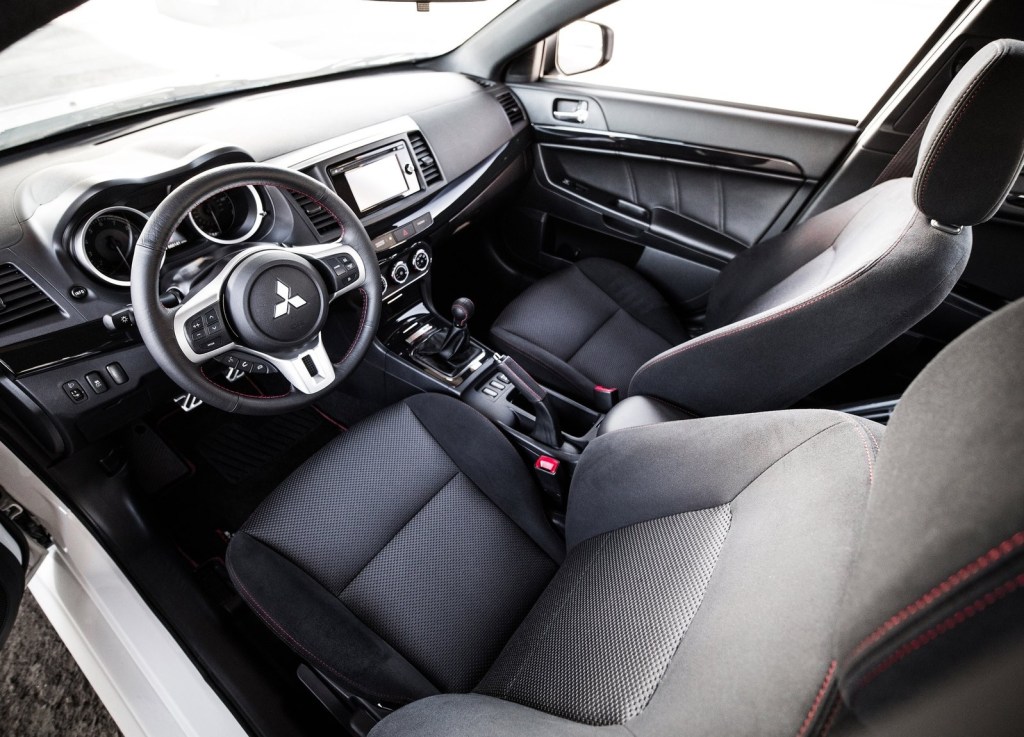
To be sure, the Mitsubishi Lancer Evo isn’t a luxury performance car. And, unlike the WRX-based Saab 9-2X, there was never a more ‘upscale’ version released. That being said, choosing between the models is fairly straightforward.
If you want an Evo for track use or as a fun weekend car, Evo X Forum and r/Mitsubishi sub-Reddit users recommend the 2003-2005 Lancer Evo VIII. The 2005 MR version is particularly desirable, due to its various factory mods.
Evolution Net forum users report the 2006-2007 Evo IX is essentially the same car, just with more power and a bit more refinement. Though, it did beat out the Evo X in MT’s track test. And CarGurus forum users rank it ahead of the Evo VIII.
The Mitsubishi Lancer Evo X, though, is a noticeably better daily-driver. It’s quieter, less frenetic, and has more modern amenities. The Recaro seats are also more comfortable, and it has a more advanced traction control system.
However, as long as the car you buy hasn’t been overly modified, the Evo can be a surprisingly reliable performance car.
Known Mitsubishi Lancer Evo problems
Reliability concerns amongst US-market Mitsubishi Lancer Evos are remarkably few and far between. In fact, OSV reports the Lancer is one of Mitsubishi’s most-reliable recent products. The 4G63 engine, EnginesWork reports, is a very robust motor. And DSport Mag reports that, although the 4B11 can’t be modded to quite the same power levels, it’s not exactly made of glass.
However, both engines require careful maintenance, as CarGurus, Evo X Forums, r/Mitsubishi, and Evolution Net forum users stress. The Evo’s engine can degrade noticeably if the oil isn’t changed roughly every 4500 miles. And both the 4G63 and 4B11 do run better with synthetic oil. In addition, all US-market Evo models need to have their transmission, rear differential, and transfer case fluid replaced roughly every 15,000 miles.
Also, the 4G63 is an interference engine, meaning if the timing belt breaks, the pistons, and valves can collide. For that reason, it’s recommended the timing belt and water pump be changed roughly every 50,000 miles, GarageDreams reports.
The 4B11, though, switched to a timing chain, which has a much longer service life. However, the timing chain in 2008-2011 models was prone to stretching. The 2012 model had a new part, which does fit the earlier Evo X cars.
Evo X-specific issues
Although clearcoat issues appear to be a common issue across the Evo generations, the X had some unique issues. Early models, Evolution Net and Evo owner forums users report, had a fuel pump relay that could fail which was rectified in later models. Also, 2008-2013 manual-equipped models were recalled over clutch master cylinder failure, Autoblog reports.
But a bigger problem was the Evo X’s Getrag-sourced dual-clutch transmission, aka the SST. It was Getrag’s first DCT, Jacks Transmissions reports, and much like Ford’s, it had some issues. The shift fork magnets and shift sensors would fail, so the car wouldn’t shift. The oil pump was also poorly lubricated, causing further jerkiness.
Part of this, Evo X Forums users muse, is that a DCT doesn’t shift quite like a manual or automatic. However, r/Mitsubishi users report it’s also not designed to handle highly-modified engines. Complicating matters, SoCalEvo reports, is that Getrag doesn’t really sell parts, but instead mostly replaces whole transmissions. Although improved parts are available, these issues can be avoided by simply getting a manual car.
Pricing
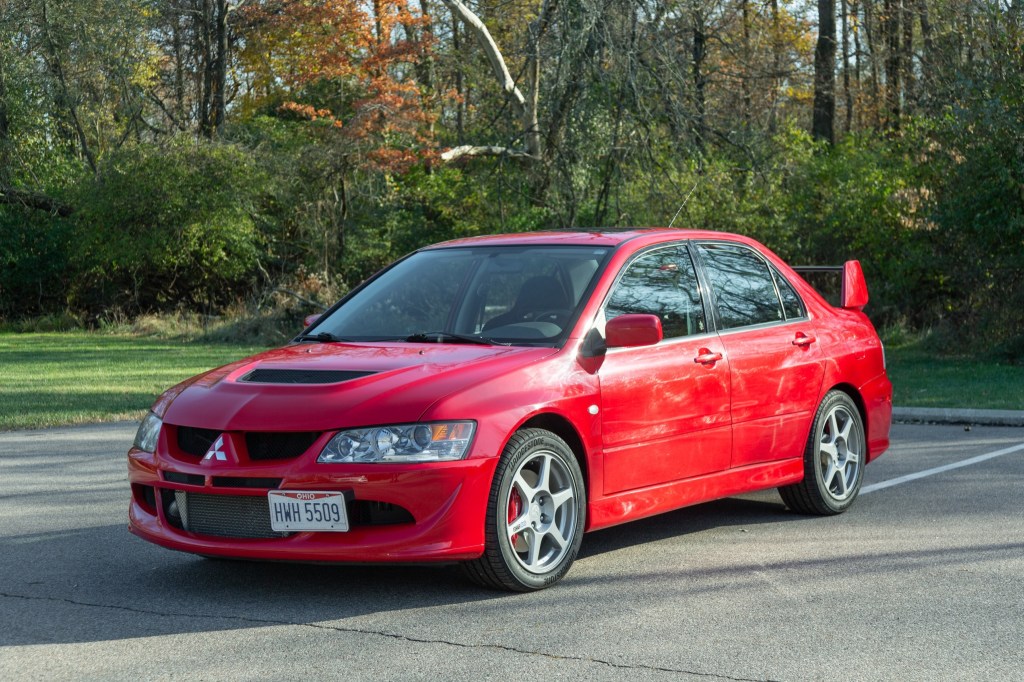
Although a Mitsubishi Lancer Evo isn’t exactly a Porsche Cayman, it is priced rather like one. A well-preserved Evo IX, Hagerty reports, can sell for $35,000-$37,000. A 2015 Final Edition can go for close to $40k on Autotrader. And in 2019, a 10,000-mile Evo IX MR sold for $39,000 on Bring a Trailer.
Luckily, most Evos on BaT usually go for about $25,000. That’s roughly what it would cost to import a JDM Evo. Though a US-market one would be noticeably more modern.
Follow more updates from MotorBiscuit on our Facebook page.

